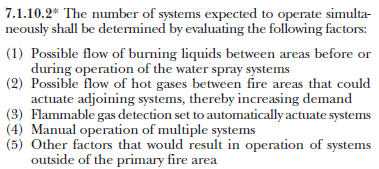FPE22
Mechanical
- Oct 8, 2015
- 16
Hello everyone, first time poster.
I need guidance in a design case I'm working on. In reference to NFPA 15, Chapter 3 Section 3.3.19.1 stating the definition of a Deluge Valve as " A type of system actuation valve that is opened by the operation of a detection system installed in the same areas as the spray nozzles or by remote manual operation supplying water to all spray nozzles ", kindly advise if a single deluge valve is sufficient to serve multiple fixed spray systems, or if each system needs its own deluge valve.
For example, if we consider a single room containing three oil-insulated transformers, where each will be protected by a deluge spray system and each will have its own heat detectors. The transformers are installed indoors, and there are no fire barriers or any partitions separating them. What would be the right approach:
1) Installing a single deluge valve to serve all the systems protecting each transformer.
2) Installing three deluge valves where each valve serves a single transformer.
Appreciate your help.
Regards,
Steve
I need guidance in a design case I'm working on. In reference to NFPA 15, Chapter 3 Section 3.3.19.1 stating the definition of a Deluge Valve as " A type of system actuation valve that is opened by the operation of a detection system installed in the same areas as the spray nozzles or by remote manual operation supplying water to all spray nozzles ", kindly advise if a single deluge valve is sufficient to serve multiple fixed spray systems, or if each system needs its own deluge valve.
For example, if we consider a single room containing three oil-insulated transformers, where each will be protected by a deluge spray system and each will have its own heat detectors. The transformers are installed indoors, and there are no fire barriers or any partitions separating them. What would be the right approach:
1) Installing a single deluge valve to serve all the systems protecting each transformer.
2) Installing three deluge valves where each valve serves a single transformer.
Appreciate your help.
Regards,
Steve

